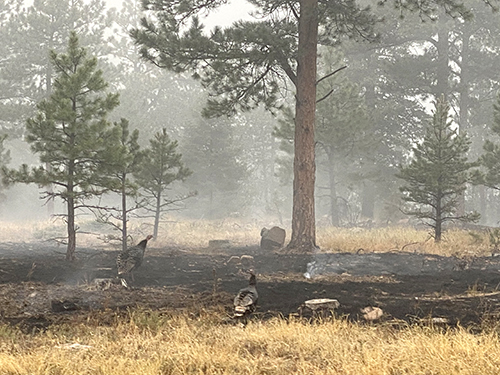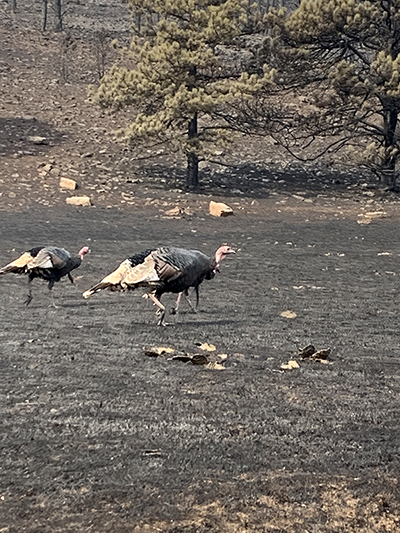After the Fire — What about the Wildlife?
By Dave Hoerath, Wildlife Biologist with Boulder County Parks & Open Space
When we hear the word wildfire these days it makes us cringe. We think of the Hayman Fire or Waldo Canyon Fire or Fourmile Fire and the toll on the human environment. Now we add Cameron Peak, East Troublesome, and CalWood fires, all with more tragic human consequences. But the CalWood Fire hit very close to home, burning 4000+ acres of our treasured Heil Valley Ranch. How do fires like these - and this one, affect wildlife?

Turkeys returning to burned areas in Heil Valley Ranch
The ponderosa pine forest ecosystem evolved with periodic fire and the burn effects of most fires are just part of the deal. Unfortunately, the CalWood Fire was a bit more intense than the normal range of fires affecting montane forests. The drouthy conditions, winds, temperature, and the fire's own heat created some severe fire behavior and severe impacts, burning whole trees, whole stands of trees, and the duff and soil beneath them. Those high severity areas aren't much for habitat anymore—unless you are a forest insect or bird that feeds on them. Conditions will be very good for that suite of species for the next few years.
But for many other species, ”home” is gone. Small mammals may have been able to get into rocks or the duff layer or those pockets of forest that didn't burn severely. But surely many animals did not make it out of the path of the fast-moving flames and toxic smoke. Abert's squirrels may have been particularly hard-hit at Heil Valley Ranch, directly and indirectly. Much of the good habitat that was occupied by squirrels is now torched matchsticks. It won't be Abert's squirrel habitat for a very long time. In fact, some areas may not revert to forest, due to the effects of climate change and the lack of seed source. We may get some conversion to grassland or shrubland as we have seen in recent severe Boulder County fires like Black Tiger, Walker Ranch, and the Overland Fire.
Mule deer © Kevin Grady
Luckily enough of a late fall fire doesn't directly affect the songbird population, which has already migrated. Birds, in general, just fly out of the burn zone and come back after the fire. However, of the returning migrants next spring, many will be forced to go somewhere else or be shoe-horned into the unburned fingers and patches of the CalWood Fire. Most larger mammals are also mobile enough to avoid fires and flamefronts. In the dark and confusion of the fire, and the difficult terrain, we have discovered some mortality in those large mammals. But we have also seen deer, elk, and turkeys back in the burned areas at Heil Valley Ranch. That habitat is likely in less-than-optimal condition. They too will likely be forced to use different areas or larger areas to make up for the habitat altered by the fire. They are lucky that portions of Heil Valley Ranch are closed to the public and that portions of the area burned will also be closed temporarily (for safety) to give them some time and space to adjust and recover.








Comments
Dave,
Thank you for this overview of the damage and survival of wildlife
Petrea Mah
Thank you Dave, We feel this deeply as Butterfliers, because we know this area so well. We hope there will be gentle moisture for the grasses and forbs to return.
Jan
Thanks for sharing this information. Would love to see more photos.
Add a Comment